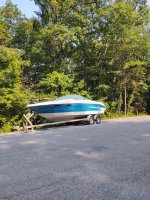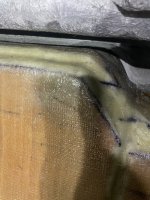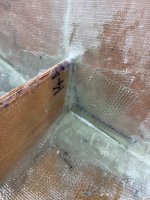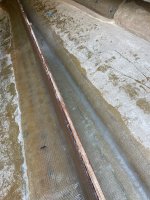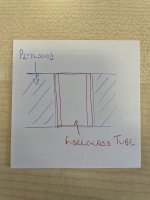Happy with the results of this weekend - stringers are glassed in.
View attachment 386715
Had to change plans a bit as I was planning to do the second layer as a single piece over the top and down both sides but trying handle 14 1/2’ long by 3 1/2’ wide of wet out 1708 on my own would have been too difficult, especially under the bow section. Instead I cut it down the centre and will do a wrap over the top of each stringer (to fully seal it) once the glass has been tidied and sanded to key it.
Question - Should I use 1708 or a csm/woven roving/csm combo? I’m leaning towards the combo as eaier to handle as individual lengths. Let me know your thoughts.
Tied each stringer back onto the transom so loads are transferred into the structure
View attachment 386716
Learning points:
1. The 1708 really doesn’t like going into tight gaps and I struggled to get it into the chine so put some pb in the starboard side to give a shallower radius
View attachment 386717
2. 1708 should be fully wet out before laying it. Best method is with a squeedgy to spread the resin.
3. Don’t bother doing neat fillets. Use the icing bag method to lay a nice thick bead into the corner and lay the wet out cloth into place. Use your hands to position it and smooth it to get the majority of the air out on one side of the fillet so it held firmly (in my case to the vertical side of the stringer). 1708 doesn’t stretch so you then use your roller to push it into the fillet and then roll the surplus pb away from the corner. Much quicker, no bubbles and no issues trying to make/sand perfect fillets. This also works to fill gaps where they were heavier on one side of a bulkhead than the other with the chopper gun and there is a step in the fibre glass thickness without having to grind loads of material out.
4. Make sure the pb has some chopped strand in it so it’s not too brittle.
Hope that makes sense - ask if it isn’t clear.
Now need to order more supplies as I’ve used about 24kg of resin, need cabosil etc. I’ll cut the bulkheads and cleats while I’m waiting. Once they’re in, on to cutting out the floor!






















